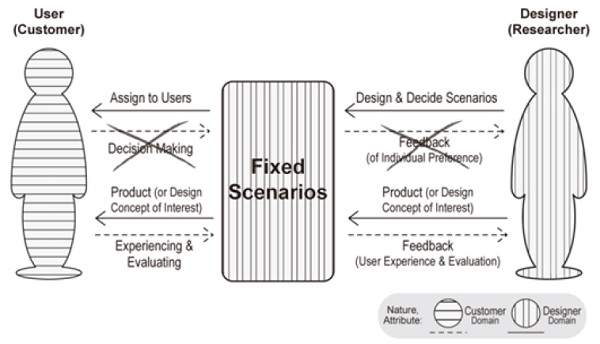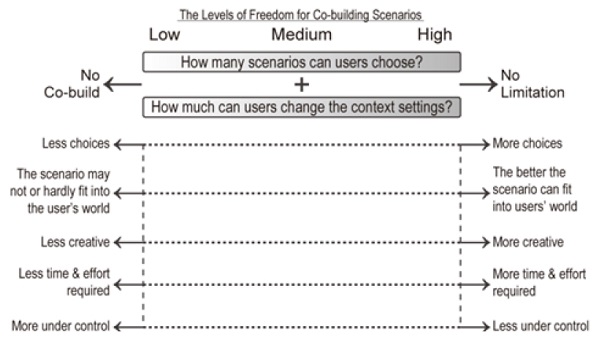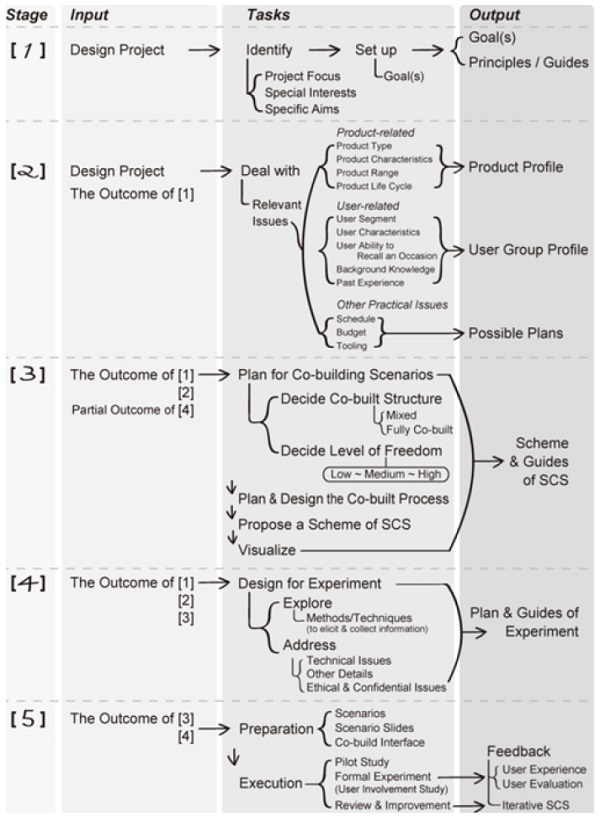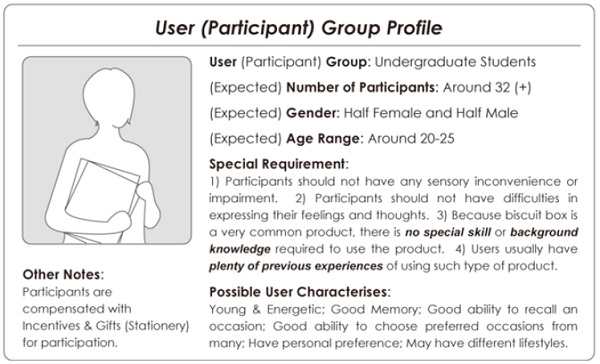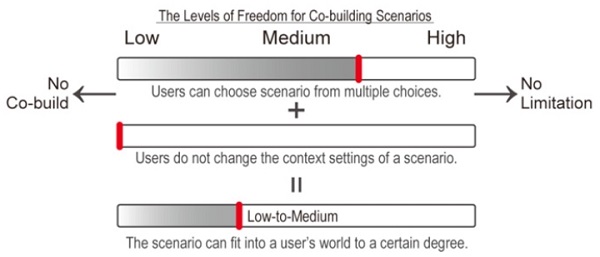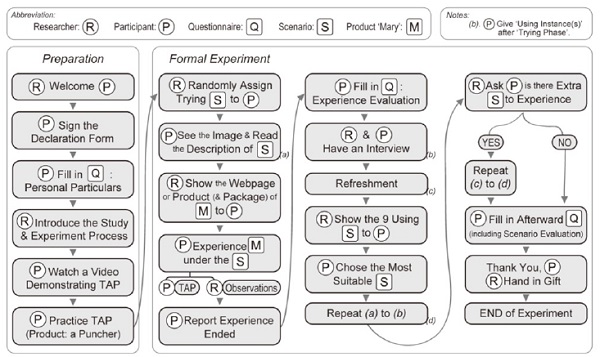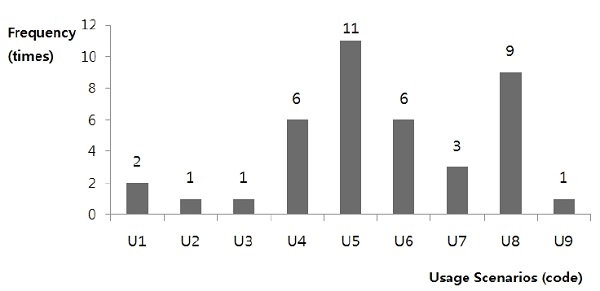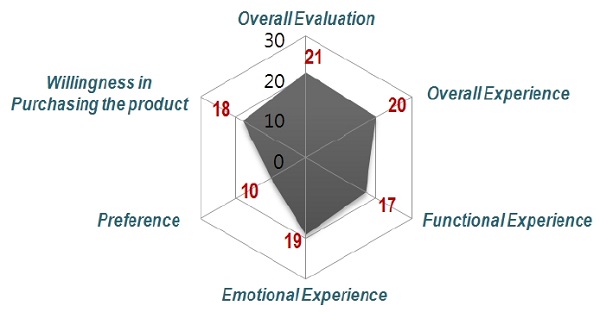
Enhancing User Involvement Studies Using a Scenario Co-build Approach
Background In user-centred design, user involvement studies are oftentimes conducted to gain an insight into user experience (UX) in order to create more consumer-focused products. However, designers usually face the issue that UX is subjective, dynamic and can be affected by diverse personal and contextual factors. Although scenario technique has been widely used to provide a specific context of use during user involvement studies, individual differences on ideal usage scenarios are frequently neglected. Consequently, it becomes a challenge for companies to offer customer-focused products with a large degree of personalization.
Methods This study revisits existing methods and proposes a prototype Scenario Co-build System (SCS) to assist designers in planning and co-building more realistic scenarios with users to strengthen the understanding of UX. The basic characteristics of co-built scenarios are presented and five development stages for implementing the SCS are described.
Results A case study was conducted to illustrate the capability of the SCS and demonstrate how designers can gain an in-depth understanding about UX. The results were promising and reveal the potential of the proposed method.
Conclusion The SCS provides more customized scenarios for users to experience a product. Designers can explore UX in a more comprehensive manner via considering individual differences and multiple contextual factors. From the case study, it appears that scenarios are capable of influencing the sensory, cognitive and affective aspects of UX. Thus, designers should pay more attention to the diversity in users' ideal usage contexts and how this may affect their product experience.
Keywords:
Design research, User Experience, User Involvement, Scenario1. Introduction
In recent years, product design and development endeavour has shifted its focus to addressing user-centred concerns (Chen, et al., 2009; Sanders 1999). Fulfilment of customers’ needs and wants has become an inevitable issue that companies have to face. Furthermore, due to severe competitions, companies need to go beyond merely satisfying average customer requirements, such as developing market-focused products, and try to incorporate a larger degree of personalization by offering customer-focused products (Jiao & Chen, 2006; Tseng & Piller, 2003). In order to achieve this goal, user involvement study has become a necessity for companies to capture valuable customer requirements. Moreover, customer requirements should include more comprehensive facets of user experience (UX) rather than focusing merely on functional or technical requirements. It is important to note that consumers care more about the value, the identity and the experience of a product rather than just the product itself (Djajadiningrat, et al., 2000). Gilovich (2010) suggested that consumers’ long-term satisfaction tended to increase for experiential purchases and decrease for material ones. Hence, in order to create long-lasting pleasing products, designers are encouraged to pay more attention to the experiential aspect of user-product interaction, to understand potential user experiences and to implement design for experience (Hassenzahl & Tractinsky, 2006; Stappers, et al., 2009).
Clause 2.15 of ISO 9241-210 (2010) broadly defines UX as a person's perceptions and responses resulting from the use and/or anticipated use of a product, system or service. It covers all possible aspects of experiencing a product that include physical, psychological, sensual, cognitive, emotional and aesthetic aspects (Forlizzi & Battarbee, 2004). Scholars also found that both internal and external factors contributed to the construction of UX (Chamorro-Koc, et al., 2009; Chong & Chen, 2010; Forlizzi & Battarbee, 2004; Hekkert & Schifferstein, 2008). The former includes users’ prior experiences, attitudes, beliefs, skills and personality, while the latter is closely related to the environment/context of use. Thus, UX inherently possesses characteristics such as being complex, subjective and dynamic (Buchenau & Suri, 2000; Zomerdijk & Voss, 2011). Without considering these inherent characteristics of UX, the customer requirements acquired may be less realistic and some important issues may be easily neglected.
UX has been well investigated. These investigations cover traditional usability, cognitive and task-oriented facets as well as more hedonistic, emotional, aesthetic and even multi-sensory aspects (Hassenzahl & Tractinsky, 2006; Norman, 2004; Schifferstein & Desmet, 2007; Schifferstein & Spence, 2008). Some researchers further examined the dynamic characteristics and assessed UX over time (Fenko, et al., 2010; Kujala, et al., 2011). However, the issue pertaining to individual differences in the context of use has yet to be adequately addressed. Although existing methods, e.g. user involvement field study, can be used to determine the actual UX more realistically, these methods are generally time-consuming and cumbersome (Vermeeren et al., 2010). In some cases, it is neither suitable nor possible to use such methods for understanding the UX. For instance, a field study may not be possible if there are confidentiality or security issues concerned. Scenario technique, on the other hand, is a lightweight method that does not have too many rules and can be adapted according to one’s purpose and needs. It has been widely used to create a specific context of use for users to experience and evaluate a product, especially during the early stage of product conceptualization. Although conventional scenario technique can be used to deal with multiple contextual factors, it is not capable of addressing the issue pertaining to individual differences in selecting suitable context of use.
Conventional scenarios used in user involvement study are usually set up by design teams based on some general assumptions about the average target users or specific imagined individuals (Suri & Marsh, 2000). As shown in Figure 1, such scenarios are usually fixed and assigned to users during the user involvement study. On the one hand, the users tend to play a passive role in responding to the contexts instead of an active role in expressing their ideas about the context of use. On the other hand, in many circumstances, the designers hold a different insight such as social environment of use with respect to the users (Chamorro-Koc, et al., 2009).
One may simply doubt the suitability of using such scenarios to address diverse individual differences (Chen, et al., 2012). This can be critical as scenarios can influence users and direct their behaviours (Go & Carroll, 2004; Rosson & Carroll, 2002). Moreover, the knowledge regarding users’ individual preference of context of use becomes tacit and unrevealed. Consequently, it becomes less likely for companies to offer the “right” customer-focused products with a large degree of personalization. Thus, it is claimed that scenarios used in user involvement studies should be closely associated with the users’ real-life experiences in order to capture more meaningful and valuable UX. Accordingly, this work proposes a scenarios co-build approach to enhance user involvement studies. It attempts to address the following issues:
(1) Are there really individual differences in users’ preferred context of use for a specific product?
(2) Is it possible for users and designers to co-build a more customized scenarios or context of use?
(3) How well can users immerse in the co-built scenarios and then experience and evaluate the product?
(4) Will the diverse contextual factors affect different aspects of UX in relation to individual differences? and
(5) How can designers investigate into this in order to gain an in-depth understanding of UX?
The concept and overall framework of a prototype Scenario Co-build System (SCS) is presented in Section 2. A case study to illustrate the capability of SCS is reported in Section 3. Section 4 discusses the results obtained. Finally, Section 5 summarises the main conclusions reached in this work.
2. Methodology
In order to facilitate the user involvement studies, individual differences should be taken into consideration when preparing the context of use for users to experience a product. The designers are also encouraged to treat users as experts of their own experience (Stappers, et al., 2009). The users are invited to play a more active role as partners or co-creators in the development of a product (Sanders, 2006). Since scenario technique has been widely used and can be easily adapted, it is anticipated that users and designers are able to co-create more realistic customized scenarios. When working jointly with the users on the scenarios, the designers are required to consider individual differences based on real situations provided by those users. In doing so, some pitfalls in scenario building, such as relying on stereotypes instead of real people, can be avoided (Suri & Marsh, 2000). Moreover, in this manner, the users may experience a product similar to what they usually do in real life and, hence, trigger the feeling of ownership of the product, which allows the users to be more emotionally attached and becomes willing to say more about their experience (Beggan, 1992; Rijn & Stappers, 2008). Consequently, the experience captured can be more reliable, valuable and closer to the truth. Furthermore, by involving the users in scenario building could naturally make the process more interesting and creative ideas can thus be generated. As a result, companies can benefit and learn more from the users. This may eventually lead to successful product innovation (Poetz & Schreier, 2012).
2. 1. An overview of the SCS
In order to tackle the subjective and dynamic characteristics of UX, the proposed SCS facilitates the user involvement study in a more proactive way. It attempts to assist the designers in the planning for user involvement study and co-building more realistic customized scenarios with the users to strengthen the understanding of UX. Accordingly, the main concept of the SCS is to provide the users with a platform for them to come up with more suitable contexts for experiencing a product.

An overall framwork of the proposed Scenario Co-build System(Note: see also the 5 stages in Figure 4)
Based on the SCS (Figure 2), the designers initially construct the basic structure of the system and plan for the user involvement study. During the user involvement study, the designers provide adequate scenarios for the users to choose or instructions to guide the users to co-build more customized scenarios. Subsequently, the users will decide the ideal using contexts that best suit their situation and experience the product based on the co-built scenarios. As a result, a more reliable and valuable UX can possibly be captured. Furthermore, the designers can acquire the knowledge pertaining to users’ individual preference of context of use as well as how and why they make such decisions. Most importantly, the designers can further observe and understand how the contexts may affect different aspects of UX in relation to individual differences. Consequently, the designers can have an in-depth understanding about the complex, subjective and dynamic experience of the users. This would possibly lead to the discovery of tacit and latent customer requirements as well as new opportunities for product innovation.
2. 2. Application of the SCS
In order to apply the SCS, it is necessary to grasp some basic characteristics of co-built scenarios. First, flexible scenario technique allows different co-built structures, namely ‘no co-built’ (or ‘fixed’), ‘mixed’ and ‘fully co-built’ scenarios. ‘No co-built’ scenarios are traditional scenarios set up by designers and users do not contribute to the context settings. On the contrary, ‘fully co-built’ scenarios enable users to play an active role in deciding all the scenarios to be adopted in the study. As for the ‘mixed’ scenarios, both ‘fixed’ and ‘co-built’ scenarios are employed. This implies that some scenarios used are assigned to the users while some are contributed by the users. Second, for the co-building part, users can have different ‘levels of freedom’ to co-build a scenario (Figure 3). They can select preferred scenarios or decide the context settings of a scenario.
By manipulating the ‘levels of freedom’, the scenarios created can possibly have a good fit with a user’s personal lifestyle and may, hence, exhibit distinct characteristics. For example, when there are a number of scenarios for selection, the ‘level of freedom’ is considered to be ‘low-to-medium’. This is similar to choosing apparel from several in a boutique. The choices available for selection, in this case, are limited. The selection process is relatively straight-forward, and little or no training is required. The designers can better control the outcomes. However, most of the scenarios for selection are not surprising in general. To overcome this shortcoming, the designers may seek users’ inputs on ideas about the context of use or potential applications such as usage instances before showing the users the scenarios prepared. Alternatively, they can ask the users for feedback after experiencing the scenarios. For higher ‘level of freedom’, the users can decide the context settings of a scenario. This results in the creation of a customized scenario which resembles the situation where one purchases clothing materials to tailor-make a dress in a specific style. In so doing, some creative and novel ideas can possibly be discovered. A fully-functional SCS is required to support the creation of a more complex co-built scenario and derive more diverse outcomes. Consequently, there will be an increase in cost, lead time and effort to realise this. The trade-off depends heavily on the product development project. In new product development, companies may aim at achieving a higher ‘level of freedom’ and yet a well-structured process so that the co-built scenarios can be more creative, closer to users’ expectation and still manageable. To do so, the designers need to start from a lower level, and gradually improve it to reach a higher level. Although the application of the SCS depends heavily on the project on hand and has to be tweaked from case to case, there are some general guidelines that can guide the designers from planning to the execution of the SCS. Five stages have been identified and are outlined as follows (Figure 4).
Stage 1. Set Up Goals
Depending on the focus of product development, the designers may choose to zoom into certain issues. In order to ensure that the SCS constructed is in line with the focus, it is imperative to identify these issues at the very beginning. After this stage, the designers will then be able to set up clear goals as well as some principles to tackle these issues.
Stage 2. Deal with Relevant Issues
Many issues may affect the ways with which scenarios are co-built. They have to be addressed before formulating the SCS’s structure. Product-related and user-related issues are two most basic but crucial items. The designers can organize relevant issues into a ‘product profile’ and a ‘user group profile’. Apart from this, attentions should also be paid to other practical issues such as project schedule, budget and tooling.
Stage 3. Propose a Scheme of SCS
After tackling all the relevant issues, the designers can decide the structure of the co-built scenario, viz. ‘mixed’ or ‘fully co-built’. As aforementioned, it is necessary to decide the ‘level of freedom’ for the co-build scenarios. Two basic situations need to be considered: (1) users can choose from multiple scenarios but cannot change the context settings of the scenario chosen; and (2) users can choose from multiple scenarios and change the context settings of the scenario chosen. For the latter, there can be many ways to decide the context settings, e.g., the users can choose to partially change the context settings based on sample scenarios or build a customized scenario from scratch. After deciding how to co-build scenarios, the designers can proceed to construct the system and propose a scheme for the SCS to guide the ‘co-build’ process. Visualization techniques can help the designers formulate possible tasks, and inputs and outputs from both the designer and the users.
Stage 4. Design for Experiment
In practice, Stages 3 and 4 are performed simultaneously. In Step 4, designers explore possible methodologies to elicit and collect information, decide where and when the study would take place, and discuss the details of the study. More specific technical issues are addressed, especially when the users are allowed to decide context settings. Ethical and confidential issues are also considered in this stage.
Stage 5. Execution
In Stage 5, the designers prepare for executing user involvement study. This includes preparing adequate scenarios and designing the ‘co-build’ interface. A pilot study to check the functions of SCS is carried out before the user involvement study. Upon completion, the designers review and improve the process to achieve a fully-functional SCS.
3. Case Study
A case study was conducted to illustrate the capability of the proposed SCS. The product used in the study is a cookie container, ‘Mary Biscuit’ of ‘Alessi’. The objectives of the case study are listed as follows. These objectives are related to the issues mentioned in the introduction.
(1) To demonstrate the application of the proposed Scenario Co-build System (SCS).
(2) To show the individual differences in ideas regarding context of use based on the same product and the necessity of providing more customized scenarios in the user involvement study.
(3) To explore the possibility of allowing users to co-build more customized scenarios.
(4) To examine users’ ability in immersing in the co-built scenarios.
(5) To examine how scenarios may affect UX.
In this case study, the authors defined the two phases of experience to be captured as follows.
(1) “ Trying Phase”: when the users purchase the product and interact with it for the first time.
(2) “ Usage Phase”: when the users get to know more about the product and have fresh experience with it.
As for the usage occasions, “daily use” and “special event” were both considered. Based on the abovementioned objectives, some relevant issues were tackled before constructing the SCS. Subsequently, a ‘product profile’ (Figure 5) to examine the issues related to the product and a ‘user group profile’ (Figure 6) to help the designers deal with user-related issues and seek appropriate participation were created. Microsoft’s PowerPoint slides were used to guide participants choosing their preferred scenarios. These scenarios were represented using descriptors in the form of textual narratives, images for the context and videos for online scenario viewing to help participants build a ‘mental model’. The time for each participant was controlled in an hour.
Upon completion, the process of co-building scenarios commenced. It included two phases of experience, namely “Trying Phase” and “Usage Phase”. “Trying Phase” provides the participants an opportunity to try-out some features and identify which feature is more obvious or appealing to them. This helped in forming the first impression about a product. A positive first impression might influence the users to make a purchase decision subsequently. At the beginning, no product information was revealed to the participants, however, without sufficient knowledge about the product, it was almost impossible for the participants to co-build a scenario. Therefore, fixed scenarios were used during the “Trying Phase”. It was assumed that after trying out the product, the participants might acquire some knowledge about it and gain adequate experience regarding how the product could be used, where to put it and even who to use it with. This had provided an opportunity for the participants to play a more active role and contribute to context settings. Co-built scenarios were then deployed during the “Usage Phase”. In this manner, the co-built scenario structure was ‘mixed’, in which the participants partially decided the scenarios to be deployed. The ‘level of freedom’ was set at “Low-to-Medium”. This implied that the participants would choose from multiple scenarios without changing the context settings (Figure 7).
During the “Trying Phase”, 4 basic scenarios were considered. For the “Usage Phase”, 9 scenarios in total were created for participants to select. The context settings for these scenarios are listed in Table 1, where the parameters for context settings include obtention, product representation, product function, packaging, companion, space and occasion.
Based on the information collated, a scheme of the SCS was proposed as shown in Figure 8. During the “Trying Phase”, random sets of fixed scenarios were assigned to the participants, which enabled them to experience ‘Mary Biscuit’ for the first time. In doing so, basic UX and evaluation could be captured. In order to gather novel ideas and avoid bias, the participants were asked to share their own ideal usage occasions or instances before viewing the usage scenarios. Subsequently, the 9 scenarios (Table 1) were shown and the participants were invited to select the most suitable one and experience ‘Mary Biscuit’ once more. In this way, designers were able to capture not only more reliable and valuable UX but also individual user preference in a manageable manner.
The experiment was conducted in a laboratory. Two notebook computers were used to respectively present scenarios and questionnaires, and two video cameras were used to record the process. The overall process for the user involvement study is shown in Figure 9. Both qualitative methods such as think-aloud protocol (TAP), observations and interviews, and quantitative method using questionnaires were used to capture different types of information. Since UX might vary under different contexts, the questions used in interviews and questionnaires were tweaked accordingly. Other than the common questions, additional questions depending on the context settings were also asked. For example, for the scenarios in which companions are around, discussion included whom the participant is with, what are the possible activities between companions and what issues they would talk about.
Upon completion, 5 participants were invited to take part in a pilot study to execute the experiment in order to ensure the user involvement process is proper and steady to be carried out formally. Subsequently, 33 participants comprising 15 female and 18 male with a mean age of 23.36 years old and age range between 20 and 26 were invited to experience and evaluate ‘Mary Biscuit’. During the “Trying Phase”, 11 participants were randomly picked and given ‘Virtual Shopping (T1 & T2)’ scenarios, another 11 participants were assigned ‘Receiving Gifts at Home (T3)’ scenario and the remaining 11 participants were asked to work on ‘Physical Shopping at Store (T4)’ scenario.
After experiencing and evaluating ‘Mary Biscuit’ once, each participant was asked about his/her ideal usage occasions or instances during an interview. Subsequently, the participants were asked to choose their preferred usage scenario(s) to experience and evaluate ‘Mary Biscuit’ again as planned.
4. Results and Discussions
Corresponding to Objective 1, the case study illustrated the application of SCS from planning to execution. The discussions outlined below are based on the qualitative information and the quantitative data collated. The qualitative information was extracted from the authors’ notes, gathered from the verbatim of TAP and were obtained by observations and during interviews. To ensure the information contributed by each participant was traceable, an identification code showing the participant’s identification number, the source and the scenario was given. For example, ‘P1, Interview, T1’ denotes that the information was provided by Participant 1 during the interview of T1 scenario. Corresponding to Objectives 2 to 5, two main issues, namely ‘individual differences and contexts’ and ‘scenarios and user experience’, are discussed as follows.
4. 1. Individual Differences and Contexts
After the “Trying Phase”, it was established that all the participants were able to provide one or more usage instances. This included also ‘T1’ scenario, where the participants did not interact with the physical product. It was found that examples of usage instances given by participants were quite diverse and possessed different characteristics. Some were linked to their current life style while some were related to their ‘dream experience’ or ‘future experience’. Although most participants came up with usage instances that were similar to or identical to the scenarios provided, some usage instances were quite different from the 9 usage scenarios provided (Table 1), such as ‘in the office’, ‘in an entertainment room’ or ‘as a gift for friends’. These additional usage instances helped in enriching the scenario database of the SCS.
As for the “Usage Phase”, the scenarios chosen by the participants varied from individual to individual. Out of the 33 participants, 7 decided to choose 2 scenarios and the rest choose 1 scenario to experience. In total, all 9 scenarios were used in this case study. Figure 10 shows the distribution of the usage of the 9 scenarios. The information collated has the following characteristics:
(1) The most popular scenario was ‘U5’, followed by ‘U8’, ‘U4’ and ‘U6’.
(2) Scenarios linked to special events (30 times) were preferred compared to those designed for daily events (10);
(3) Scenarios associated with companionship (31) were more popular than those without (9); and
(4) Scenarios with indoor activities (30) were more frequently chosen than those with outdoor activities (10).
The results revealed that the participants appeared to have their own ideas about the context of use for the same product. This also confirmed the necessity to provide the participants with more customized scenarios for them to experience and evaluate a product in the user involvement study.
Some of the reasons for rejecting a scenario appeared to be fairly similar. These included ‘big’, ‘heavy’, ‘bulky’, ‘hard to carry’ and ‘the lid not secured’ for the scenarios to bring ‘Mary Biscuit’ outdoor (U8 and U9). In addition, those who chose the same scenario seemed to give similar reasons. For example, ‘aesthetic’ was the main reason for choosing the ‘U5’ scenario. To these participants, ‘Mary Biscuit’ was special for its visual appearance that made it aesthetically presentable. Such an impression was further enhanced by coupling it with other sensory design features such as a vanilla scented and biscuit-like lid, which made it an ideal commodity for festive seasons.
4. 2. Scenarios and User Experience
Scenarios and its context settings seem to influence UX in many different ways. The following discussion uses ‘companionship’ as an example to address the issue.
On the one hand, ‘Mary Biscuit’ seemed to suit ‘U5’ scenario well. Its design features had attracted much attention and facilitated interaction with the participants. Apparently, the experience ‘Mary Biscuit’ provided would influence the participants in deciding its suitability for a particular context of use. Similar observations could also be obtained in other scenarios (U2, U4, U7, U8 and U9) where contexts of use were linked to companionships. Different types of social events were mentioned repeatedly by the participants. ‘Mary Biscuit’, unlike common containers, was able to help ‘break the ice’, provided a talking point and facilitated interactions. On the other hand, for scenarios that were not associated with companionship such as ‘Examination (U6)’, the participants seldom selected ‘Mary Biscuit’ up from the desk and cared less about its appearance. In addition, more emotions were invoked when the context settings were associated with companionship. Some participants also felt that their experience would be different if there were people around. Thus, it can be deduced that contextual factors such as companionship may influence users’ attitudes, thoughts, behaviour and emotions.
Context settings are scenarios dependent. Likewise, the intents of a participant to experience a product under different scenarios vary. For example, during the “Trying Phase”, the intent of experiencing ‘T1’ scenario was to get to know ‘Mary Biscuit’ in order to create a ‘mental model’ and make a purchasing decision while the purpose of attempting ‘T2’ scenario was to examine ‘Mary Biscuit’ and compare it with the expected experience.
Additional information would also influence participants’ behaviours. For example, participants who had experienced ‘T1’ scenarios that were provided with product specifications would examine the product at the very beginning in ‘T2’ scenario. Whereas, those who tried ‘T3’ and ‘T4’ scenarios, in which product specifications were not provided, started by making different guesses about the possible usage of ‘Mary Biscuit’. In ‘T2’ and ‘T3’ scenarios, ‘Mary Biscuit’ was packed in a box. This permeated a feeling of mystery. Consequently, all the participants seemed to be very happy and elated when the box was opened.
Some participants preferred to use different containers in different occasions. For example, some felt that ‘Mary Biscuit’ was suitable for special occasions but might not be appropriate for daily usage due to functional concerns. It is apparent that scenarios possess the power to influence UX in many ways including sensory, cognitive and affective aspects.
Apart from qualitative reasoning, the influence of scenarios can also be assessed quantitatively. In this work, questionnaires were used to solicit the assessments of the participants after experiencing each scenario. Seven criteria, namely overall evaluation, functional experience, emotional experience, and sensory experience of four senses including vision, touch, audition and olfaction were used. The sensory experience then further covered design features, sensory importance, sensory influence and experience evaluation.
A single factor ANOVA (analysis of variance) was conducted to ascertain the effect of scenarios by participants and the seven criteria. The significance of scenarios by each participant’s evaluations with respect to the seven criteria were assessed using a three-point scale, where “1”, “2” and “3” denoted ‘insignificant’, ‘moderately significant’ and ‘significant’, respectively. Subsequently, the scores for each participant and each criterion were accumulated separately.
Notation:
(A) – overall evaluation; (B) – functional aspect; (C) – emotional aspect; (D) – visual experience; (E) – tactile experience; (F) – auditory experience; (G) – olfactory experience;
[( )/a] – 7–point semantic differential; [( )/b] – design features/variables; [( )/c] – sensory influence; [( )/d] – the entire of the aspect
It is apparent that scenarios have an effect on individuals as well as on the various aspects of criteria. The single factor ANOVA for scenarios and participants (Table 2) shows that the average and the range of the scores registered are 25.58 and 14 (spanning from 21 to 35) respectively. Thirteen (13) participants scored higher than the average. Among them, 7 were assigned ‘T1’ and ‘T2’ scenarios, 4 with ‘T3’ and 2 with ‘T4’ scenarios during the “Trying Phase”. It appears that those who experienced ‘T1’ and ‘T2’ scenarios tend to give a higher score. This also implies that in virtual shopping, the gap between ‘expected experience’ and ‘actual experience’ can be large at times. Frequently, the users tend to have a higher expectation of the product. Hence, such a phenomenon needs to be taken into account when user involvement study is to be conducted virtually.
As for the single factor ANOVA for scenarios and criteria (Table 3), the average and range of the scores registered are, respectively, 40.19 and 24 (spanning from 33 to 57). Criteria ‘overall evaluation’, ‘emotional experience’, ‘visual experience – design features’, ‘tactile experience – design features’, and ‘olfactory experience – design features and experience evaluation’ had received above average scores. Hence, the scenarios presented appeared to have a greater influence on these criteria.
In addition, a post-survey was carried out at the end of experiment. The results, as summarized in Figure 11, show that scenarios can have influence on ‘overall experience’, ‘overall evaluation’, ‘functional experience’, ‘emotional experience’ and ‘willingness in purchasing product’ for most participants and on ‘preference’ for a few participants.
Thus, apart from scenarios can direct users’ attention (Rosson & Carroll, 2002) and guide user involvement (Go & Carroll, 2004), this work further suggests that scenarios can influence UX in various aspects.
The easiness of imagining a new product or experience may affect users’ attitudes and evaluation behaviour (Zhao, et al., 2012). Thus, it was postulated that the ability of the participants in imagining a scenario might also have a bearing on the quality of UX captured. This study investigated how well a participant can imagine a scenario via two ways, namely the objective and subjective ways. First, techniques based on cognitive science such as TAP can be used to perform an objective assessment of the extent of immersion. Using TAP, the participants can spontaneously share their experience and thoughts. In this work, some participants were able to describe the scene in their own words vividly or even stand in others’ shoes in the scenario experience. Second, asking the participants directly can be used to obtain a more subjective assessment. In this work, the participants filled in a questionnaire consulting their ability to visualise the scenarios. The results (Figure 12) suggested that 82% of the participants could possibly visualise the scenarios, while 18% of them might have problem to do so. Together with previous evidence that all the participants are able to give usage instances, choose ideal usage scenarios for ‘Mary Biscuit’, and experience it accordingly, this work has shown that there are good chances for the participants to co-build more customized scenarios.
5. Conclusions
In this work, a prototype Scenario Co-build System (SCS) was proposed and implemented to facilitate the user involvement study. It assists designers in co-building more realistic scenarios with users. This may help users to link-up the product usage with their real life activities and, hence, enable them to play a more active role and contribute more insights of their experiences to facilitate the design of a more consumer-focused product. Although the focus and interests of a project may vary largely from case to case, some general guidelines can be followed to guide designers in constructing a suitable SCS scheme for user involvement study. In this work, a case study was conducted to illustrate the capability of the prototype system. From the case study, it appears that the proposed SCS could effectively support the user involvement study. On the one hand, the participants are capable of forming their own ideal usage instances and deciding preferred usage scenarios to experience and evaluate the product. The necessity to provide more customized scenarios for users to experience a product in user involvement study is ascertained. It has also been established that scenarios possess the power to influence UX in many ways including sensory, cognitive and affective aspects. Therefore, designers should be mindful about contextual factors while conducting user research and developing design concepts. On the other hand, designers are able to discuss unrevealed and tacit but yet valuable knowledge such as how individual differences may affect the users’ ideal usage scenarios and how the context of use may affect different aspects of UX in relation to individual differences. In other words, companies can have a more in-depth understanding about UX as well as the users. Such knowledge can be helpful not only for designers to create more consumer-focused and experience-oriented products but also for planning or marketing department to improve customer relationship management. Consequently, it is more plausible for companies to identify opportunities for product innovation.
Future work includes the realisation of a potpourri of tools to handle the complex, subjective and dynamic UX and the organisation, integration and implementation of experiential knowledge. To gain a competitive edge, it is worthwhile to develop a scheme utilizing the proposed SCS with higher level of freedom to facilitate new product development.
Notes
Copyright : This is an Open Access article distributed under the terms of the Creative Commons Attribution Non-Commercial License (http://creativecommons.org/licenses/by-nc/3.0/), which permits unrestricted educational and non-commercial use, provided the original work is properly cited.
References
- Beggan, J. K. (1992). On the social nature of nonsocial perception: The mere ownership effect. Journal of Personality and Social Psychology, 62(2), 229-237.
- Buchenau, M., & Suri, J. F. (2000, August). Experience prototyping. In Proceedings of the 3rd conference on Designing interactive systems: processes, practices, methods, and techniques (pp. 424-433). ACM.
- Chamorro-Koc, M., Popovic, V., & Emmison, M. (2009). Human experience and product usability: Principles to assist the design of user-product interactions. Applied ergonomics, 40(4), 648-656.
- Chen, C. H., Sato, K., & Lee, K. P. (2009). Editorial: Human-centered product design and development. Advanced engineering informatics, 23(2), 140-141.
- Chen, N. F., Chen, C. H., Khoo, L. P., & Foo, C. (2013). An Investigation Into Dynamic Multi-Sensory Product Experience Based on Online Shopping. In Concurrent Engineering Approaches for Sustainable Product Development in a Multi-Disciplinary Environment (pp. 897-908). Springer London.
-
Chong, Y. T., & Chen, C. H. (2010). Customer needs as moving targets of product development: a review. The International Journal of Advanced Manufacturing Technology, 48(1-4), 395-406.
[https://doi.org/10.1007/s00170-009-2282-6]

-
Djajadiningrat, J. P., Overbeeke, C. J., & Wensveen, S. A. G. (2000, April). Augmenting fun and beauty: a pamphlet. In Proceedings of DARE 2000 on Designing augmented reality environments (pp. 131-134). ACM.
[https://doi.org/10.1145/354666.354680]

- Fenko, A., Schifferstein, H. N., & Hekkert, P. (2010). Shifts in sensory dominance between various stages of user-product interactions. Applied ergonomics, 41(1), 34-40.
- Forlizzi, J., & Battarbee, K. (2004, August). Understanding experience in interactive systems. In Proceedings of the 5th conference on Designing interactive systems: processes, practices, methods, and techniques (pp. 261-268). ACM.
- Carter, T. J., & Gilovich, T. (2010). The relative relativity of material and experiential purchases. Journal of Personality and Social Psychology, 98(1), 146.
- Go, K., & Carroll, J. M. (2004). The blind men and the elephant: Views of scenario-based system design. interactions, 11(6), 44-53.
- Hassenzahl, M., & Tractinsky, N. (2006). User experience-a research agenda. Behaviour & Information Technology, 25(2), 91-97.
- Hekkert, P., & Schifferstein, H. N. (2008). Introducing product experience. Product experience, 1-8.
- DIS, I. (2009). 9241-210: 2010. Ergonomics of human system interaction-Part 210: Human-centred design for interactive systems. International Standardization Organization (ISO). Switzerland.
-
Jiao, J. R., & Chen, C. H. (2006). Customer requirement management in product development: a review of research issues. Concurrent Engineering, 14(3), 173-185.
[https://doi.org/10.1177/1063293X06068355]

- Kujala, S., Roto, V., Väänänen-Vainio-Mattila, K., Karapanos, E., & Sinnelä, A. (2011). UX Curve: A method for evaluating long-term user experience. Interacting with Computers, 23(5), 473-483.
-
Norman, D. A. (2004). Emotional design: Why we love (or hate) everyday things. Basic books.
[https://doi.org/10.1145/985600.966013]

-
Poetz, M. K., & Schreier, M. (2012). The value of crowdsourcing: can users really compete with professionals in generating new product ideas?. Journal of Product Innovation Management,29(2), 245-256.
[https://doi.org/10.1111/j.1540-5885.2011.00893.x]

- van Rijn, H., & Stappers, P. J. (2008, October). Expressions of ownership: motivating users in a co-design process. In Proceedings of the Tenth Anniversary Conference on Participatory Design 2008 (pp. 178-181). Indiana University.
- Rosson, M. B., & Carroll, J. M. (2009). Scenario based design. Human-computer interaction. Boca Raton, FL, 145-162.
- Sanders, E. B. N. (1999). Postdesign and participatory culture. Proceedings of Useful and Critical: The Position of Research in Design. University of Art and Design, Helsinki.
- Sanders, E. B. N. (2006). Design research in 2006. Des. Res. Q. 1 (1), 1-8.
- Schifferstein, H. N., & Desmet, P. M. (2007). The effects of sensory impairments on product experience and personal well-being. Ergonomics, 50(12), 2026-2048.
- Schifferstein, H. N., & Hekkert, P. (Eds.). (2011). Product experience. Elsevier.
- Stappers, P. J., van Rijn, H., Kistemaker, S. C., Hennink, A. E., & Sleeswijk Visser, F. (2009). Designing for other people’s strengths and motivations: Three cases using context, visions, and experiential prototypes. Advanced Engineering Informatics, 23(2), 174-183.
- Fulton Suri, J., & Marsh, M. (2000). Scenario building as an ergonomics method in consumer product design. Applied ergonomics, 31(2), 151-157.
- Tseng, M. M., & Piller, F. (2003). The customer centric enterprise-advances in mass customization and personalization. Berlin: Springer Verlag.
- Vermeeren, A. P., Law, E. L. C., Roto, V., Obrist, M., Hoonhout, J., & Väänänen-Vainio-Mattila, K. (2010, October). User experience evaluation methods: current state and development needs. In Proceedings of the 6th Nordic Conference on Human-Computer Interaction: Extending Boundaries (pp. 521-530). ACM.
-
Zhao, M., Hoeffler, S., & Dahl, D. W. (2012). Imagination Difficulty and New Product Evaluation. Journal of Product Innovation Management, 29(S1), 76-90.
[https://doi.org/10.1111/j.1540-5885.2012.00951.x]

-
Zomerdijk, L. G., & Voss, C. A. (2011). NSD processes and practices in experiential services*. Journal of Product Innovation Management, 28(1), 63-80.
[https://doi.org/10.1111/j.1540-5885.2010.00781.x]

